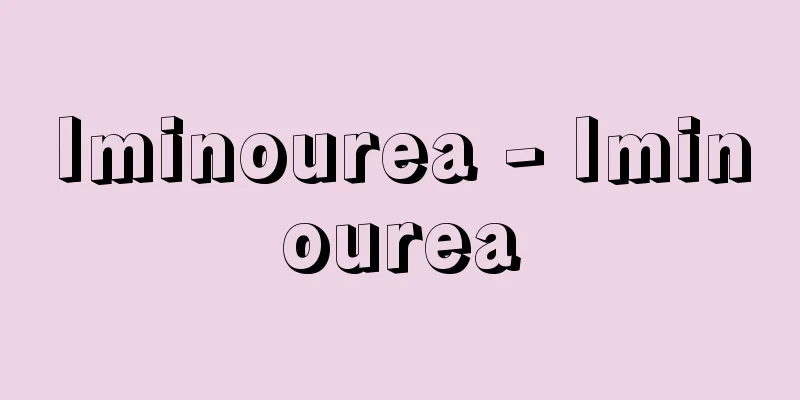Mercantilism (English spelling)

|
It refers to the economic thought that dominated European countries from the late 16th century to the 18th century. Capitalist production reached a new turning point with the discovery of the New World at the end of the 15th century and the development of the East Indies sea route. Geographical discoveries rapidly expanded the world market, and at the same time, fierce commercial battles broke out between the countries of Spain, the Netherlands, England, and France over the products, resources, and colonies of the new markets. In particular, gold and silver mines were discovered in Bolivia and Mexico around the middle of the 16th century, which led to a dramatic increase in Europe's gold and silver reserves. With this historical background, it was only natural that the economic thought known as mercantilism was born. In the 16th century, the so-called early mercantilism, or mercantilism, was born, and from the 17th century, the later, developed, original mercantilist system appeared. The term mercantilism was not used by those who belonged to this school, but was used later by the French Physiocrats and Adam Smith of the British Classical School, who took a critical stance against mercantilism. Influenced by the Renaissance, the Mercantilists observed economic phenomena objectively and causally, without unnecessarily attaching religious or ethical value or criticizing them. Moreover, they elevated the methods of making money and commerce, which had been deemed lowly by Aristotle and medieval monk lawyers, to the center of the economy, and made the promotion of such methods the guiding principle of a country's economic policy. The views of those who are generally called mercantilists differ considerably on individual points and do not form a coherent system, but their main focus can be summarized as follows. First, mercantilists considered gold, silver, and coins to be the most valuable and everlasting treasures of a nation's wealth, and placed the emphasis of the nation's economic policy on increasing this treasure. Second, mercantilists who placed importance on money considered earning profits to be exactly the same as increasing money, and understood that money is generated by buying goods cheaply and selling them at a high price, that is, from the difference between the price at which goods are bought and sold. Therefore, in terms of profit, commerce came to be considered to be superior to agriculture and industry. Third, although commerce is a powerful means of earning profits, domestic commerce does not contribute to the increase of a nation's wealth. This is because the seller's profit is the buyer's loss, and there is no positive profit generated when viewed as a nation as a whole. Moreover, Europe's domestic production of gold and silver was small, with most of it coming from the New World, mainly through Spain. Fourthly, they came to the general conclusion that in order to actively increase a country's gold and silver stocks, it must export more goods than it imports, making the difference in foreign trade favorable, and allowing the difference in gold and silver to flow into the country. Mercantilists studied ways to increase gold and silver from this perspective. Moreover, early mercantilists looked at money from the perspective of a wealth-hoarder, and once money flowed into the country, they held on tightly to it, never letting it flow out of the country. Based on their argument, European countries adopted strict bans on the export of gold and silver, and severely punished those who broke the law and took gold and silver out of the country. However, they realized that such policies hindered the development of foreign trade and were not a good way to acquire gold and silver. Therefore, later and more developed mercantilists argued that it was wiser to earn profits by controlling money, rather than looking at it from the perspective of a wealth-hoarder. They did not restrict the import of goods from abroad or prohibit the export of gold and silver, as the early mercantilists did, but instead tried to increase the inflow of gold and silver by exporting goods worth more than the goods imported. The doctrine of mercantilism developed from the theory of the difference in money to the theory of the difference in trade. Mercantilism emerged as an eloquence of capital, especially commercial capital. Therefore, many of its advocates came from the merchant class. Representative mercantilists include Bodin, Thomas Mann, Antonio Serra (1580-?), and Antoine de Montchrétien (1575/76-1621). In particular, Thomas Mann, an executive of the British East India Company, dedicated his life to the development of Britain's foreign trade and wrote a will for his son John called "The Treasure of England by Foreign Trade". It was published in 1664 after Thomas' death. As Adam Smith commented, the measures contained in this book became the basis of economic policy not only for Britain but for all other commercial countries. Mercantilism's trade policies included the prohibition of imports of foreign goods, high import tariffs, export subsidy systems, protection and growth of export industries, and the promotion of venture merchants and state-sponsored companies. The British East India Company, founded in 1600, played an active role on the international stage as the star of mercantilist policies. Similar companies were established in succession in countries such as the Netherlands, France, Denmark, Sweden, and Prussia, and fierce commercial competition developed between them. In particular, in France, Colbert, the finance minister of Louis XIV, enforced extreme mercantilist policies, and his methods came to be called Colbertisme. Mercantilism also had to face contradictions. When one country adopted mercantilist policies, other countries would counter it with the same tactics, setting up tariff barriers to restrict imports and hinder foreign trade. The free trade policies of Physiocrats and the Classical School were advocated to overcome mercantilism. [Koshimura Shinzaburo] "The Economic Theory of Mercantilism by Noboru Kobayashi (1952, Toyo Keizai Shinposha)" [References] | | |Source: Shogakukan Encyclopedia Nipponica About Encyclopedia Nipponica Information | Legend |
|
16世紀末から18世紀にかけてヨーロッパの国々を支配した経済思想をさす。 資本主義生産は、15世紀末に行われた新大陸の発見や、東インド航路の開拓によって新しい転機を迎えた。地理上の発見によって世界市場は急速に広がり、それとともに新市場の生産物と資源、植民地の獲得をめぐって、スペイン、オランダ、イギリス、フランスの諸国の間に激しい商業戦が展開された。とくに16世紀のなかばごろ、ボリビアとメキシコで金鉱や銀鉱が発見され、それによってヨーロッパの金銀の貯蔵量は飛躍的に増大した。 こうした歴史的な背景のもとに、重商主義とよばれる経済思想が生まれてきたのは自然の成り行きであった。16世紀には、いわゆる初期重商主義、あるいは重金主義とよばれる主張が生まれ、17世紀からは後期の、発展した本来の重商主義体系が出現した。なお、重商主義ということばは、この派に属する人々によっては使われず、のちに重商主義に対して批判的立場にたったフランスの重農主義者や、イギリス古典学派のアダム・スミスによって用いられたのである。 重商主義者たちはルネサンスの影響を受けて、経済現象を、いたずらに宗教的に、倫理的に価値づけたり、非難したりしないで、それを客観的に、因果論的に観察した。しかも彼らは、アリストテレスや中世の寺院法学者によって卑しいものと決めつけられていた金もうけの方法や商業を、経済の中心に引き上げ、それを振興することを一国の経済政策の指導原理としたのである。 普通、重商主義者とよばれている人々の見解は、個々の点についてみるとかなり違っており、一貫した体系をなしていないけれども、その主眼とするところは、次の点に要約される。第一に、重商主義者たちは、一国の富のうち、金銀貨幣をもっとも貴重な、永久不滅の財宝とみなし、一国の経済政策の重点を、この財宝の増大に置いたことである。第二に、貨幣を重視する重商主義者は、利潤を獲得することと、貨幣を増やすことをまったく同じものと考え、そして貨幣は、商品を安く仕入れて高く売ることから、つまり売買の差額から生まれてくるものと理解した。だから利殖という点からすると、農業や工業よりも商業のほうが優位にたつものとみなされるようになった。第三に、商業は利潤の獲得の強力な手段ではあるが、国内の商業は一国の富の増進に寄与しない。なぜなら、売り手の利益は買い手の損失であって、一国全体としてみると、そこに積極的な利潤が発生しないからである。しかもヨーロッパでは金銀の国内産出量はわずかであって、その大半は新大陸から、主としてスペインを通じて入手していたのである。そこで、第四に、彼らは次のような一般的結論に達した。一国の金銀を積極的に増やすには、商品の輸入額よりも輸出額を多くし、外国貿易の差額を有利にして、その差額だけ金銀を自国に流れ込むようにしなければならないというのである。 重商主義者たちはこのような観点にたって金銀の増加策を研究した。しかも初期の重金主義者たちは、貨幣を蓄財家の目をもって眺め、いったん国内に流れ込んだ貨幣はしっかりと握り締めて、絶対に国外に流出させまいとした。彼らの主張に基づいて、ヨーロッパの国々は厳重な金銀の輸出禁止策を採用し、法律を破って金銀を国外に持ち出す者を厳しく罰したのである。しかし、このような政策はかえって外国貿易の発展を妨げ、金銀を獲得する良策でないということに気がついた。そこで後期の発展した重商主義者たちは、貨幣を蓄財家の目で眺めないで、それを運転することによって利潤を得たほうが賢明であると説いた。彼らは、初期の重金主義者のように、外国から商品を輸入することを制限したり、金銀を持ち出すことを禁止したりしないで、輸入した商品よりも多くの額の商品を輸出することによって、金銀の流入を図ろうと努力した。重商主義の学説は、貨幣差額論から貿易差額論へと発展したのである。 重商主義は、資本の、とりわけ商業資本の通弁として現れてきた。だからこの主義の主唱者の多くは商人階級から出ている。ボーダン、トーマス・マン、セラAntonio Serra(1580―?)、モンクレティアンAntoine de Montchrétien(1575/76―1621)などが、代表的な重商主義者に数えられている。とりわけイギリスの東インド会社の重役であったトーマス・マンは、生涯をイギリスの外国貿易の発展のために捧(ささ)げるとともに、『外国貿易によるイギリスの財宝』という遺言書を息子のジョンのために書き残した。それはトーマスの死後1664年に出版された。アダム・スミスが批評したように、この本に盛られた方策は、イギリスばかりでなく他のすべての商業国の経済政策の基本となったのである。 重商主義の貿易政策は、外国品の輸入禁止や、高率の輸入関税政策や、さらにそれと並んで、輸出奨励金制度、輸出品工業の保護伸長政策、および冒険商人や国策会社の活動を奨励する政策に向けられていった。1600年に創設されたイギリスの東インド会社は、重商主義政策の花形として国際舞台のうえで活躍した。同種の会社は、オランダ、フランス、デンマーク、スウェーデン、プロシアなどの諸国で相次いで設立され、それらの間で激しい商業上の競争が展開された。とりわけフランスでは、ルイ14世の大蔵大臣コルベールが極端な重商主義政策を強行したので、その方策はコルベルティスムColbertismeともよばれるようになった。 重商主義もまた矛盾に突き当たらざるをえなかった。一国が重商主義政策をとると、他国もまたこの方策をもって対抗し、互いに関税の障壁を設けて、輸入を抑制し、外国貿易を阻害するようになるからである。重農主義や古典学派の自由貿易政策は、重商主義を克服するために提唱されたのである。 [越村信三郎] 『小林昇著『重商主義の経済理論』(1952・東洋経済新報社)』 [参照項目] | | |出典 小学館 日本大百科全書(ニッポニカ)日本大百科全書(ニッポニカ)について 情報 | 凡例 |
<<: Children with severe physical and mental disabilities
Recommend
Kijima Plateau
A plateau in the west of Beppu City, Oita Prefect...
Kawasho (Kabuki)
...In addition, Jihei and Osan are cousins, so th...
Juichiya Gisaburo - Juichiya Gisaburo
Novelist. Born in Kobe. After enduring hardships ...
Occlusion
This refers to the phenomenon in which a gas or l...
Kamaboko (fish cake) - Kamaboko
One type of fish paste product. In ancient documen...
Loxosoma
…Colonial bryozoans spread asexually by attaching...
Francien
...the language was formed in northern France by ...
Fiscal year - kaikei nendo (English spelling) fiscal year
Although the financial activities of national and...
Antoine Pinay
1891‐1994 French politician. Served as Minister of...
Kayuda Tsuneto - Kayuda Tsuneto
...The manor office and market were located in Sa...
Kishiha
A school of painting from the late Edo period thr...
Shizuna Kusano - Kusano Shizuna
...A powerful samurai family in Hizen and Chikugo...
Petion, AS (English spelling) PetionAS
…In 1801, the constitution was established and he...
Court Dance - Court Dance
...This concept of court music is deeply connecte...
canton
… [Hidetoshi Kato] [National flag specifications ...









